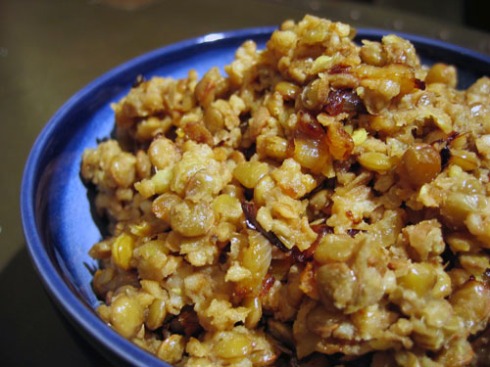Sadly for Australian readers, the best of British spring/summer seasonal food has, via the markets, gripped my imagination, so recipes like this one (not nearly as exciting in an Aussie winter) may just need to be saved for a few months. Sorry.
Gazpacho
Ingredients (makes 4 serves)
- 1kg very ripe tomatoes, diced
- 1 green and 1 red pepper, cut into small pieces
- 1 cucumber, peeled and diced
- 2 cloves of garlic, peeled
- 10 tbsp extra-virgin olive oil
- 3 tbsp sherry or wine vinegar
- 100g (4 slices) day-old white bread (crusts removed and soaked in water for an hour)
- a pinch of cumin (to taste)
- 2 tsp salt
- 2 glasses of water
- salt & pepper
Method
- Put the tomatoes, peppers and cucumber in a large bowl.
- Add the garlic, oil and vinegar. The correct amounts of oil and vinegar make the difference between good and delicious gazpacho, and you must use extra-virgin olive oil for the perfect flavour.
- Squeeze the excess water from the bread and add it, stirring the ingredients together.
- Pour into a blender and mix gently.
- Once you have a smooth consistency use the back of a ladle to push the soup through a sieve, and if it’s too thick add water – as gazpacho is eaten cold it should taste light and refreshing and have a liquid consistency.
- Add the cumin and salt, cover and refrigerate until cold.
- Serve with small bowls of the soup ingredients to garnish to taste
Notes
- This recipe is lifted from here, after seeing it in yesterday’s Observer Magazine – it is from Elena Meneses de Orozco, the wife of the Spanish ambassador. She says, in theinterview with Laura Potter:
“When we were little, my sister and I used to help my mother make gazpacho. Every household in Spain has a slightly different version, but my mother taught me this one and I’ve passed it on to the embassy chef, Rafael Perez. The traditional recipe was just water, bread, vinegar and garlic (poor vineyard workers ate it while working). The tomatoes and peppers were added when Columbus brought them to Spain in 1492. Now, summer isn’t summer without gazpacho – every family in Spain eats it every day for three months.”

